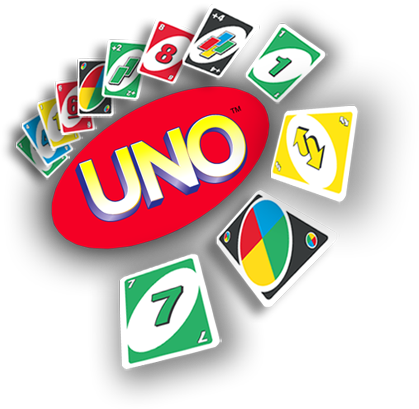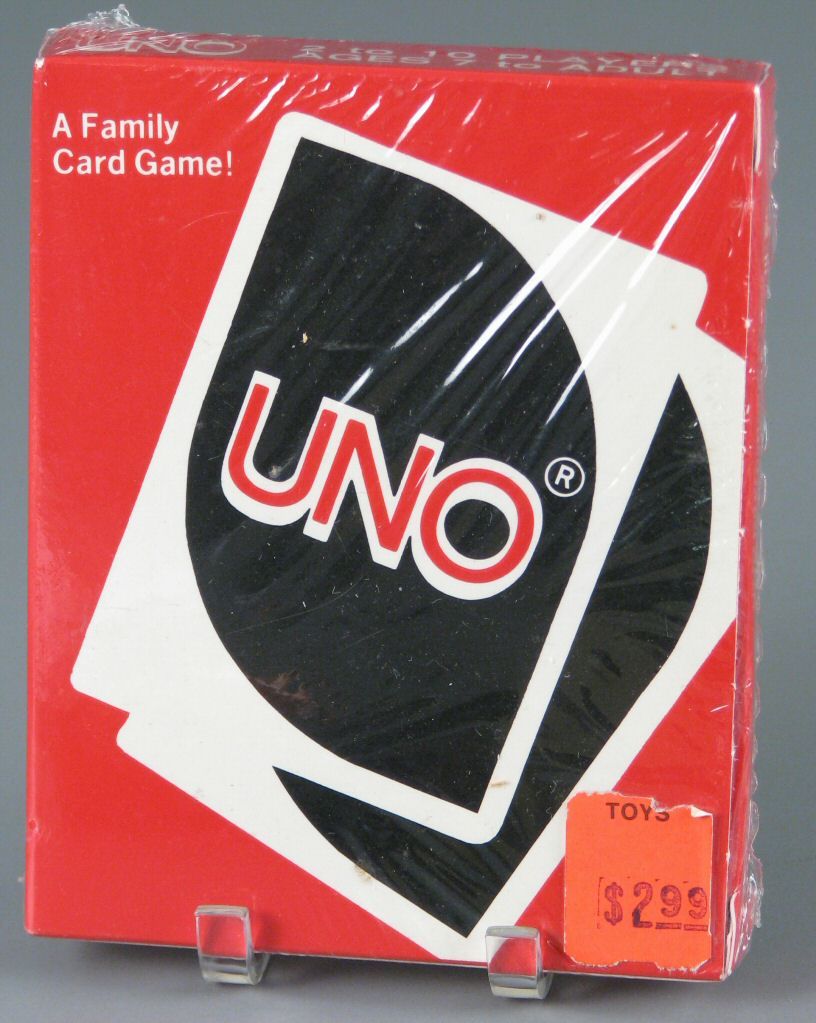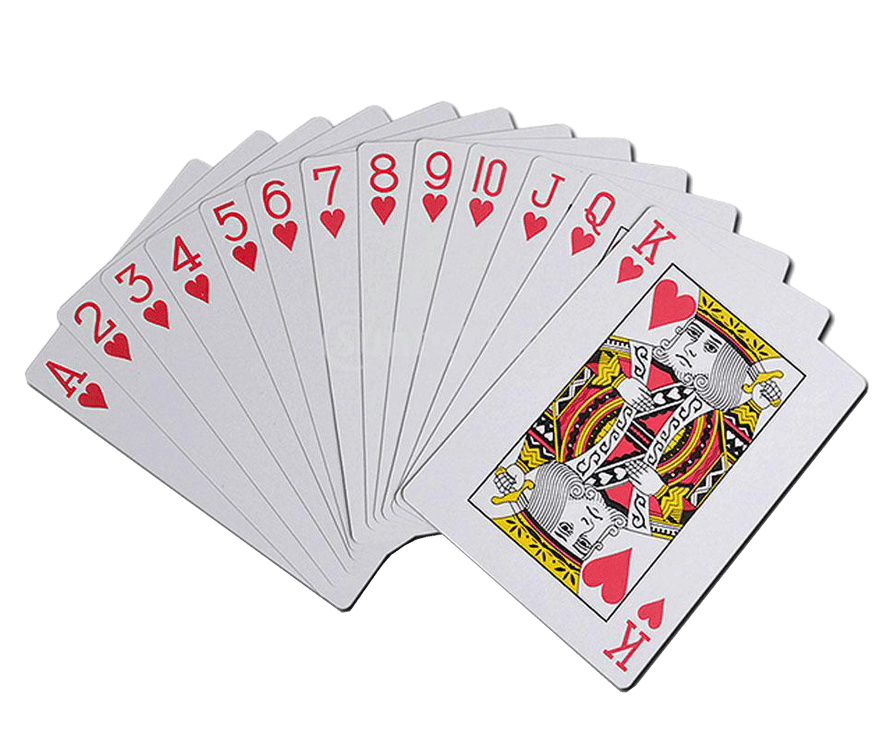UNO - Easy to Learn - Hours of play
By Merle Robbins, International Games, and Mattel

UNO

- Designers: Merle Robbins Gaylor in Redding, Ohio
- Publisher: Merle Robbins, International Games, and Mattel
- Release Date: 1971
- Players: 2 - 10
- Ages: 7 and up
- Playing Time: 30 to 45 minutes
Setup
An easy to learn card game that is fun for the whole family. Set down cards matching by color or number. Play a wild card to change color or another action card to slow down your opponents. Be the first to empty your hand of cards, but do not forget to yell Uno! when you get down to one card in your hand!
The game is for 2-10 players, ages 7 and up. Every player starts with seven cards, and they are dealt face down. The rest of the cards are placed in a Draw Pile face down. Next to the pile a space should be designated for a Discard Pile. The top card should be placed in the Discard Pile, and the game begins!
Game Play
The first player is normally the player to the left of the dealer (you can also choose the youngest player) and gameplay usually follows a clockwise direction. Every player views his/her cards and tries to match the card in the Discard Pile.
You have to match either by the number, color, or the symbol/action. For instance, if the Discard Pile has a red card that is an 8 you have to place either a red card or a card with an 8 on it. You can also play a Wild card (which can alter current color in play).
If the player has no matches or they choose not to play any of their cards even though they might have a match, they must draw a card from the Draw pile. If that card can be played, play it. Otherwise, keep the card, and the game moves on to the next person in turn. You can also play a Wild card, or a Wild Draw Four card on your turn.
Note
If the first card turned up from the Draw Pile (to form the Discard Pile) is an Action card, the Action from that card applies and must be carried out by the first player to go (as stated, it is usually the player to the dealer’s left). The exceptions are if a Wild or Wild Draw Four card is turned up.
If it is a Wild card, the first player to start (usually the one on the dealer’s left), can choose whatever color to begin play. If the first card is a Wild Draw Four card – Return it to the Draw Pile, shuffle the deck, and turn over a new card. At any time during the game, if the Draw Pile becomes depleted and no one has yet won the round, take the Discard Pile, shuffle it, and turn it over to regenerate a new Draw Pile.
Take note that you can only put down one card at a time; you cannot stack two or more cards together on the same turn. For example, you cannot put down a Draw Two on top of another Draw Two, or Wild Draw Four during the same turn, or put down two Wild Draw Four cards together.
The game continues until a player has one card left. The moment a player has just one card they must yell “Uno!” If they are caught not saying “Uno” by another player before the next player has taken their turn, that player must draw two new cards as a penalty. Assuming that the player is unable to play/discard their last card and needs to draw, but after drawing, is then able to play/discard that penultimate card, the player has to repeat the action of calling out “Uno.” The bottom line is — Announcing “Uno” needs to be repeated every time you are left with one card.
Once a player has no cards remaining, the game round is over, points are scored, and the game begins over again. Normally, everyone tries to be the first one to achieve 500 points, but you can also choose whatever points number to win the game, as long as everyone agrees to it.
Action Cards
Reverse
If going clockwise, switch to counterclockwise or vice versa. It can only be played on a card that matches by color, or on another Reverse card. If turned up at the beginning of play, the dealer goes first, and the player to the dealer’s right is next (normally it would be the player to the dealer’s left).
Skip
When a player places this card, the next player has to skip their turn. It can only be played on a card that matches by color, or on another Skip card. If turned up at the beginning of play, the first player (to the dealer’s left) loses his/her turn. The next player to that player’s right starts the game instead.
Draw Two
When a person places this card, the next player will have to pick up two cards and forfeit his/her turn. It can only be played on a card that matches by color, or on another Draw Two. If turned up at the beginning of play, the first player draws two cards and gets skipped.
Wild
This card represents all four colors, and can be placed on any card. The player has to state which color it will represent for the next player. It can be played regardless of whether another card is available. If turned up at the beginning of play, the first player chooses what color to continue play.
Wild Draw Four
This acts just like the wild card except that the next player also has to draw four cards as well as forfeit his/her turn. With this card, you must have no other alternative cards to play that matches the color of the card previously played. If you play this card illegally, you may be challenged by the other player to show your hand to him/her. If guilty, you need to draw 4 cards. If not, the challenger needs to draw 6 cards instead. If turned up at the beginning of play, return this card to the Draw pile, shuffle, and turn up a new one.
Stacks or Pills
This is the most confusing part of the card. Most players get confused in which stack is stockpile or draw pile. There is a total of Four stacks in the game. Below is the explanation of each stack.
#1. Stock Stack
These stack are the card which you get at the beginning of the game, it will 20 or 30 accordingly to how many players are playing. This stack is placed on the right of each player face down and the top card faces up.
#2. Draw stack
Draw stack are in many popular card games. The stack is the remaining cards after giving each player 20 or 30 cards. The stack will be placed in the middle, so every player can reach the draw stack. This stack is used for maintaining the required card to play the game ( for example – skip bo game requires you to have 5 cards in hand every time. So whenever any player left with less than 5 cards. The player will draw the cards to make 5 cards in hand.
#3. Building stack
you can only build four of this stack. These stacks will be used to get rid of your cards. This building stack is build up in numerical order. This means the stack will start from “1” or skip bo card can be used as “1” to start the stack and this number goes to 12. Once a stack is completed. It gets removed from the building place and a new stack will start.
#4. card Stack
just like building a stack, you can only build four discard stacks. This stack will be on the left of the stock stack. You can put any card in a discard stack. But the only top card can be played during the game.
Scoring and Winning the game
Scoring comes when you play more than 1 or 2 games in skip bo. If you are playing multiple games and want to record the score. The rule of scoring is simple:
The winner of each game will get 25 points for winning the game and 5 points for every card in their opponent’s stock stack. ( for example. You won the game and your opponent left with 3 cards in the stockpile. In that case you will get 25 + 5*3cards = 40 points). The player who collects 500 points first wins the game.
